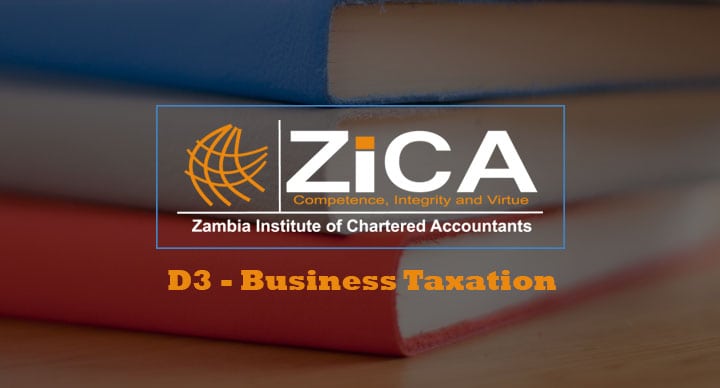D3 – Business Taxation
No access plans exist.

Course Features
Course Details
D3-BUSINESS TAXATION
This Paper builds on the knowledge gained in Paper D 4 – Direct Taxes. It covers topics such as Sole trader income tax, Partnerships, Taxation of Mining Operations, Taxation of Farming enterprises, Taxation of Insurance & Financial Services, Tax Aspects of Corporate Social Responsibility, Taxation of Consolidated Groups, Corporate Mergers, Acquisitions & Disposals, Taxation of Financial Arrangements and the tax treatment of Liquidations and Insolvency.Objectives
On completion of this paper, the student should be able to:- Discuss the characteristics of various business organisations from a tax point of view,
- Calculate Income tax payable by sole traders on their business profits,
- Calculate income tax payable by partners on their share of business profits,
- Calculate income tax payable by incorporated businesses on their trading income,
- Explain the characteristics of mining operations and calculate income tax payable on mining income,
- Explain the characteristics of farming and fishing enterprises and calculate income tax thereon,
- Apply the principles of income tax to insurance and financial services sectors,
- Apply the VAT principles to various business transactions,
- Apply the principles of Customs and Excise Duties to various business transactions,
- Discuss the role of the employer as regards employees’ tax affairs.
Structure of the examination paper
There shall be a three hour examination consisting of four (4) compulsory questions of twentyfive (25) marks each. Candidates will be allowed fifteen minutes’ reading and planning time.Detailed syllabus
- UNIT 1 - BUSINESS ORGANISATIONS
- Element 1: Characteristics of sole proprietorships
- Element 2: Characteristics of partnerships
- Element 3: Characteristics of incorporated businesses
- Element 4: Distinguishing features of various business organisations
- UNIT 2 - SOLE TRADERS’ BUSINESSES AND INCOME TAX
- Element 1: Computing business profits, including capital allowances
- Element 2: Accounting dates and basis of assessment
- Element 3: Trading losses
- Element 4: Computing and paying income tax on business profits
- UNIT 3 - PARTNERSHIPS AND INCOME TAX
- Element 1: Computing taxable business profits of partnerships
- Element 2: Capital allowances for partnerships
- Element 3: Allocation of partnership profits between partners
- Element 4: Changes in partnership agreement
- Element 5: Payment of income tax by partners
- UNIT 4 - INCORPORATED BUSINESSES AND INCOME TAX
- Element 1: Residence of companies
- Element 2: Computing taxable income of companies
- Element 3: Payment of income tax by companies
- UNIT 5 - MINING OPERATIONS
- Element 1: The characteristics of Mining Operations
- Element 2: Treatment of Revenue and Capital Expenditure
- Element 3: Mining Tax losses
- Element 4: Tax incentives for mining operations
- Element 5: Capital Allowances for Mining Companies
- Element 6: Indexation of Mining Losses and Capital Allowances
- Element 7: Maintenance of Books in Foreign Currency
- Element 8: Thin Capitalization Element
- 9: Environmental Expenditure
- Element 10: Tax Treatment of Hedging Income
- Element 11: Income Tax Computations for Mining Operations
- Element 12: Mineral Royalty Tax
- Element 13: Variable Profit Tax
- UNIT 6 - FARMING ENTERPRISES AND INCOME TAX
- Element 1: Characteristics of farming and fishing enterprises
- Element 2: Computing farming profits for companies
- Element 3: Capital allowances for farming enterprises
- Element 4: Averaging of farming and fishing income
- UNIT 7 - INSURANCE AND FINANCIAL SERVICES
- Element 1: Computing taxable income for insurance companies
- Element 2: Computing taxable income for Banks
- Element 3: Computing income tax payable by insurance companies
- Element 4: Computing income tax payable by Banks
- UNIT 8 - VALUE ADDED TAX
- Element 1: Registration and deregistration to include groups and branches
- Element 2: Further aspects of the tax point on specialized transactions
- Element 3: VAT application to farming and mining enterprises
- Element 4: VAT on insurance and financial services products
- Element 5: VAT on imports and exports
- Element 6: Reverse Charge VAT
- Element 7: Pre- registration input VAT
- Element 8: Sale of business compared with sale of individual assets
- UNIT 9 - CUSTOMS AND EXCISE
- Element 1: Importation of business assets
- Element 2: Exports and their tax treatment
- Element 3: Rules of origin and tax implications
- Element 4: Trade agreements and their benefits to the economy of Zambia
- UNIT 10 - CONSOLIDATED GROUPS
- Element 1: Income Tax Assessment of Consolidated Groups
- Element 2: Treatment of Entry and Exits from a Group
- Element 3: Treatment of Group Losses
- Element 4: Property Transfer Tax for Groups of Companies
- UNIT 11 - CORPORATE SOCIAL RESPONSIBILITIES
- Element 1: The Meaning of Corporate Social Responsibility
- Element 2: Donations to Government Institutions
- Element 3: Donations to Charitable Organisations
- Element 4: Donations to Political Parties & Similar Ventures
- UNIT 12 - TAKEOVERS, MERGERS, ACQUISITIONS & DISPOSALS
- Element 1: Legal rules applicable in the taxation of corporate mergers and acquisitions, particularly as they apply to consolidated groups;
- Element 2: Legal and tax structures used for corporate mergers and acquisitions in practice; and
- Element 3: Modifications for restructures, group takeovers and acquisitions, including the treatment of losses in mergers and acquisitions and Liability issues and tax sharing agreements;
- Element 4: Demergers and Deemed Dividends
- UNIT 13 - FINANCIAL ARRANGEMENTS
- Element 1: General tax policy and financial principles relevant to the income tax treatment of financial instruments;
- Element 2: Zambian tax law applicable to financial instruments including debt/equity rules and finance leases;
- Element 3: Debt-financing techniques, particularly the treatment of interest surrogates and hybrid debt instruments;
- Element 4: Equity-financing techniques and the classification of instruments as debt or equity; Element 5: Income tax treatment of hedging transactions and synthetic instruments;
- Element 6: Income tax issues raised by the cross-border use of financial instruments; and
- Element 7: Finance leasing and infrastructure finance.
- UNIT 14 - CORPORATE INSOLVENCY & RECONSTRUCTION
- Element 1: The aims of insolvency law, historical background, basic concepts and definitions
- Element 2: Assets available for distribution: The ranking of claims, proprietary and non- proprietary claims and their significance, equitable interests, retention of title, set-offs and other forms of quasi-security
- Element 3: Groups of companies and the liability of officers: Pooling, directors’ duties and liability for insolvent trading
- Element 4: Liquidation: Winding up in insolvency
- Element 5: Avoidance of antecedent transactions
- Element 6: Corporate rescue: Voluntary administration and deeds of company arrangement
- Element 7: Receivers and agents: Appointment, duties and liabilities of receivers and liquidators
- Element 8: Employee entitlements
- Element 9: Reconstruction Schemes
- Element 10: Directions to liquidators, receivers, administrators and deed administrators
- Element 11: Liquidation Dividends
Reading material
- ZICA, Business Taxation, 2010 edition, Lusaka
This course does not have any sections.





